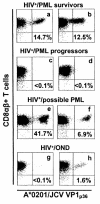Low frequency of cytotoxic T lymphocytes against the novel HLA-A*0201-restricted JC virus epitope VP1(p36) in patients with proven or possible progressive multifocal leukoencephalopathy
- PMID: 14581528
- PMCID: PMC254255
- DOI: 10.1128/jvi.77.22.11918-11926.2003
Low frequency of cytotoxic T lymphocytes against the novel HLA-A*0201-restricted JC virus epitope VP1(p36) in patients with proven or possible progressive multifocal leukoencephalopathy
Abstract
JC virus (JCV)-specific cytotoxic T lymphocytes (CTL) in peripheral blood are associated with a favorable outcome in patients with progressive multifocal leukoencephalopathy (PML). However, the frequency of these cells in the peripheral blood mononuclear cells (PBMC) of PML patients is unknown. To develop a highly sensitive assay for detecting the cellular immune response against this virus, we performed a CTL epitope mapping study of JCV VP1 major capsid protein by using overlapping peptides. A novel HLA-A*0201-restricted epitope, the VP1(p36) peptide SITEVECFL, was characterized. The cellular immune response against JCV was assessed in 32 study subjects. By combining the results of the (51)Cr release assay on pooled peptides and staining with the HLA-A*0201/JCV VP1(p36) tetramer, VP1-specific CTL were detected in 10 of 11 PML survivors (91%) versus only 1 of 11 PML progressors (9%, P = 0.0003). VP1-specific CTL were also detected in two of two patients recently diagnosed with PML and in four of four human immunodeficiency virus-positive patients with possible PML. The frequency of CTL specific for the novel VP1(p36) and the previously described VP1(p100) epitopes was determined. In two patients, the frequency of CTL specific for the VP1(p36) or VP1(p100) epitopes, as determined by fresh blood tetramer staining (FBTS), ranged from 1/6,000 to 1/24,000 PBMC. A CTL sorting technique combining tetramer staining and selection with immunomagnetic beads allowed the detection of epitope-specific CTL in two cases that were determined to be negative by FBTS. The phenotype of these CTL in vivo was consistent with activated memory cells. These data suggest that, although present in low numbers, JCV-specific CTL may be of central importance in the containment of JCV spread in immunosuppressed individuals.
Figures



References
-
- Agostini, H. T., C. F. Ryschkewitsch, E. J. Singer, R. W. Baumhefner, and G. L. Stoner. 1998. JC virus type 2B is found more frequently in brain tissue of progressive multifocal leukoencephalopathy patients than in urine from controls. J. Hum. Virol. 1:200-206. - PubMed
-
- Altman, J. D., P. A. H. Moss, P. J. R. Goulder, D. H. Barouch, M. G. McHeyzer-Williams, J. I. Bell, A. J. McMichael, and M. M. Davis. 1996. Phenotypic analysis of antigen-specific T lymphocytes. Science 274:94-96. - PubMed
-
- Ammassari, A., A. Cingolani, P. Pezzotti, D. A. De Luca, R. Murri, M. L. Giancola, L. M. Larocca, and A. Antinori. 2000. AIDS-related focal brain lesions in the era of highly active antiretroviral therapy. Neurology 55:1194-1200. - PubMed
-
- Ault, G. S., and G. L. Stoner. 1992. Two major types of JC virus defined in progressive multifocal leukoencephalopathy brain by early and late coding region DNA sequences. J. Gen. Virol. 73:2669-2678. - PubMed
-
- Berger, J. R., R. M. Levy, D. Flomenhoft, and M. Dobbs. 1998. Predictive factors for prolonged survival in acquired immunodeficiency syndrome-associated progressive multifocal leukoencephalopathy. Ann. Neurol. 44:341-349. - PubMed
Publication types
MeSH terms
Substances
Grants and funding
LinkOut - more resources
Full Text Sources
Other Literature Sources
Research Materials

